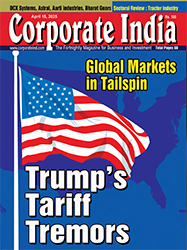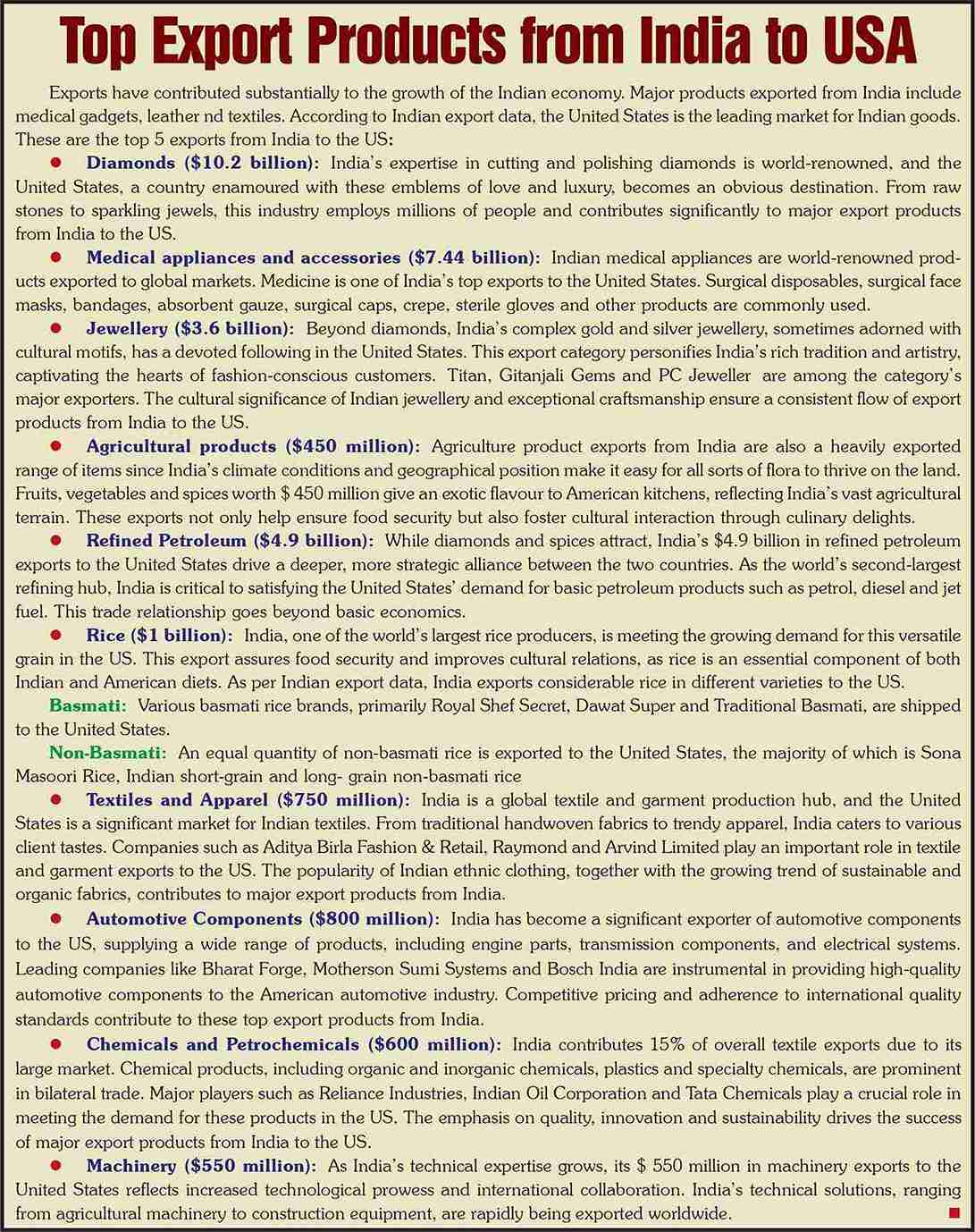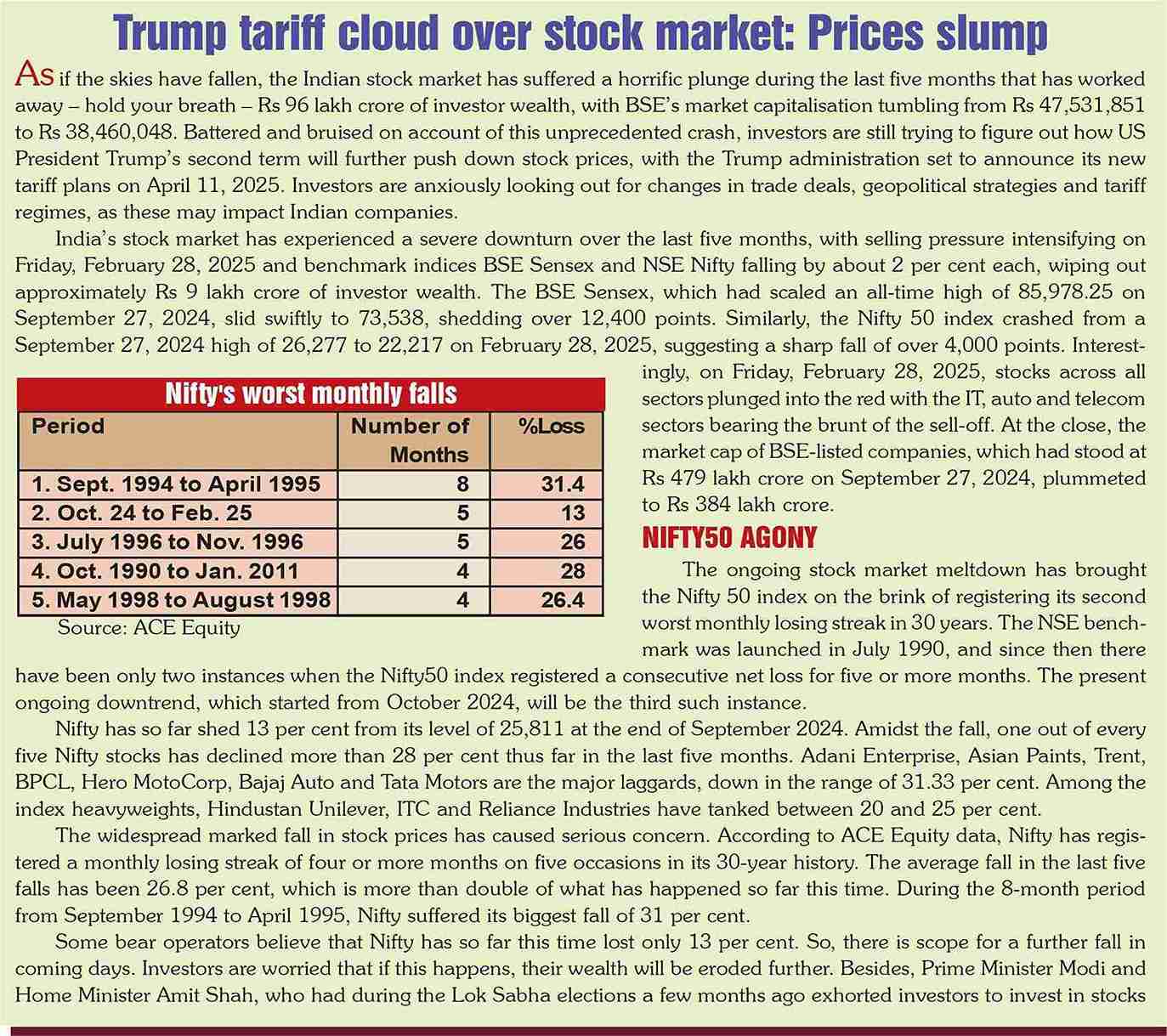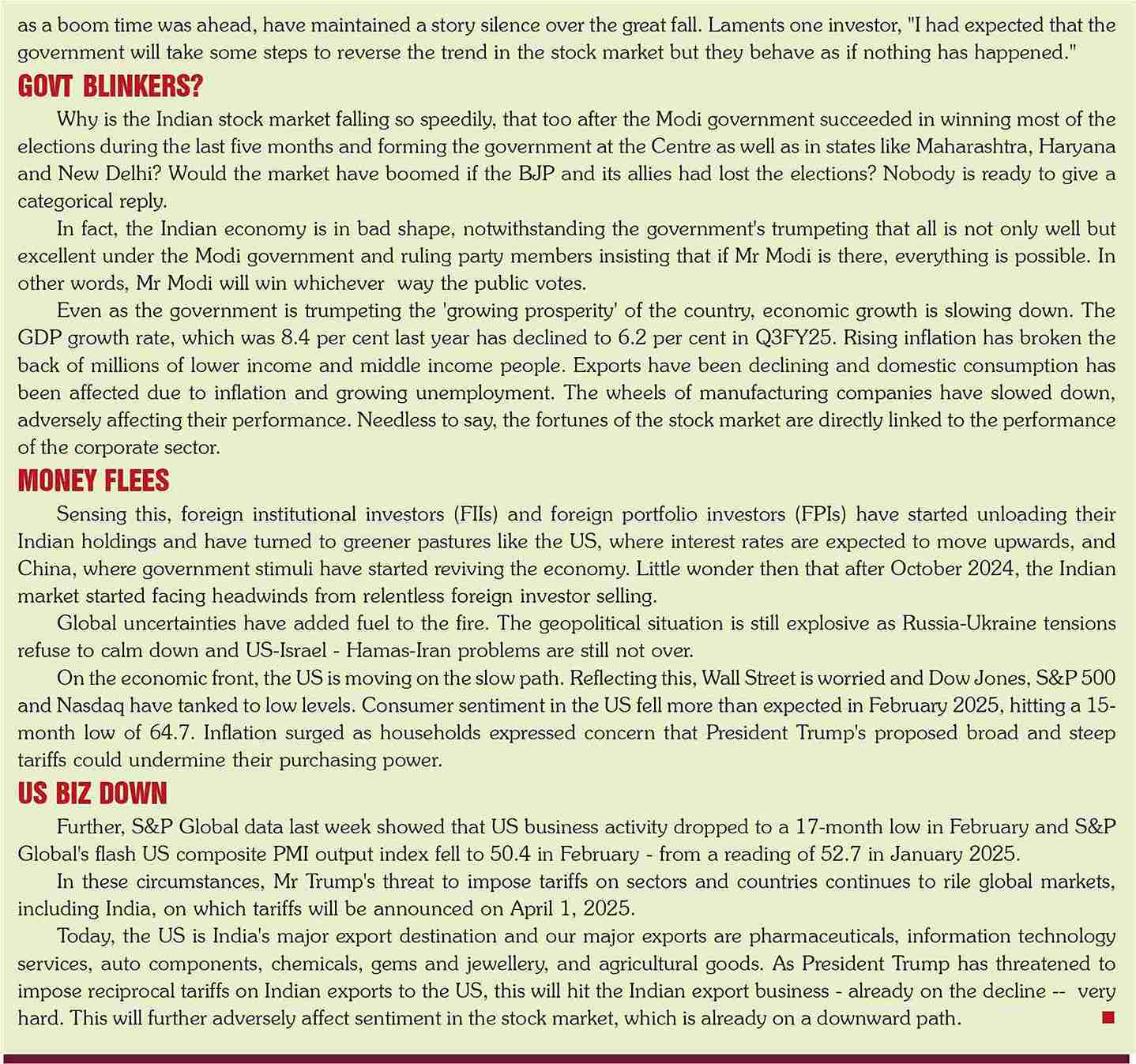Want to Subscribe?
Read Corporate India and add to your Business Intelligence

![]() Unlock Unlimited Access
Unlock Unlimited Access

Published: February 28, 2025
Updated: February 28, 2025
US President Donald Trump has sent shock waves across the globe, including India, with his ‘America First’ policy of slapping punitive tariffs on the US’s trade partners in response to what he believes are unfair tariffs by other countries on US exports.
While his logic may be sound, the fact that the US remains the world’s most powerful nation, both economically and militarily, means that the new US tariffs will largely dictate the pace and shape of the global economy in the years to come.
The Indian economy is already feeling the ‘Trump effect’, with the domestic stock market nosediving from its high of September 2024, and the spectre of a stronger US dollar further diminishing the already low exchange value of the rupee.
INDIAN economy will be ruined with wheels of manufacturing slowing down further, capital formation plummeting inflationary price spiral skyrocketing and lives of low as well as middle income people becoming all the more miserable.
However, there could be a silver lining too as manufacturing companies shift base from major US trade partners like China and Japan to developing countries like India. Again the PM Modi should persuade Mr. Trump to give India liberal concessions as India has agreed to buy oil, gas and F35 jets from the US.
The ascendancy of Donald Trump, the mav erick politician and businessman, to the US President’s ‘throne’ for the second time may not augur well for India. Though Indian Prime Minis ter Narendra Modi did not attend Mr Trump’s swearing-in ceremony of the President, it was because he was not invited and not to show India’s disappointment over Mr Trump’s hardline domestic stance.
India, however, has no reason to welcome Mr Trump’s second innings as his election has brought in a lot of fears, uncertainties and negative implications. The Indian economy, which has started slowing down over the last 150 days, has suffered a further setback on account of Mr Trump’s election. Trade and industry circles are a terribly worried lot, and the stock market has crashed, with investors’ wealth tumbling from Rs 47,534,851.61 on September 30, 2024 to Rs 39,721,225.36 on February 25, 2025. Foreign institutional investors (FIIs) and for eign portfolio investors (FPIs) have been dumping Indian stocks and the outflow during the last two months (January and February 2025) has crossed Rs 1 lakh crore!
As a result of this selling avalanche, the Sensex, the most popu lar stock market index based on prices of 30 pivotal stocks quoted on the BSE, has nosedived from its recent high of 85,978.25 (on Sep tember 23, 2024) to 74,602.12, reflecting a sharp fall of and the Nifty, the darling index of analysts based on the prices of 50 leading stocks quoted on the NSE, has slid from 26,277.35 to 22,747.55, suggesting a fall of around 13 per cent. Market sentiment has turned distinctly bearish and prices are likely to go down further in the ab sence of any clear policy announcement by President Trump, who has made the Mr Modi nervous by threatening to impose reciprocal tariff duties on India.

In fact, there are growing apprehensions globally that President Trump’s policies related to trade, immigration and climate change could profoundly impact the global economic landscape.
As the US today is the world’s largest economy and a leading military power, it has a significant influence over global economic growth and international peace efforts. It is very easy to understand the impor tance of the Trump government’s policies for the global economy and markets. Even as the fundamental drivers of US domestic and foreign policy will remain constant, the maverick Mr Trump’s policies will certainly differ from those of Joe Biden and other previous US Presi dents. Almost all foreign policy experts – American and others – agree that Mr Trump’s return to the White House will certainly bring about a seismic shift in the global economic and po litical landscape.
In fact, after his election and before his swearing-in as Presi dent, Mr Trump had already revealed his mind through certain statements indicating that he was going to revise US tariff policy. Soon after his inauguration, he imposed a 25 per cent tariff on imports from Canada and Mexico, and a 10 per cent tariff on Chinese imports. And at Mr Modi's recent meeting with Mr Trump, he was bluntly told by the President that the US would impose reciprocal tariffs on Indian exports to the US.
After assuming office on January 20, 2025, President Trump has ordered the administration to draft broad new tariffs on US trade partners, including India, which could take effect from April 1, 2025.
Experts opine that Mr Trump's policies are expected to be relatively expansionary, potentially leading to higher in flation. As the US Federal Reserve has stated that it will remain data-dependent while deciding the trajectory of in terest rates, higher inflation could mark the end of the mon etary easing cycle in the US. This in turn could drive up bond yields and strengthen the US dollar, a key negative for emerging countries like India.
Little wonder then that with the beginning of Mr Trump's second term as US President, there are growing apprehen sions that his policies on trade, immigration and climate change, could profoundly impact the global economic land scape.
Another disturbing optic that played out even as Mr Modi was in the US was the spectacle of illegal Indian immi grants being deported on military aircraft back to India in handcuffs. A hapless Indian Prime Minister could only com ment that the deported Indians were victims of human traf ficking.
And after Mr Modi returned home, President Trump blacklisted four Indian companies for entering into deals with Iranian petroleum companies, with a warning to the Modi government to 'keep away' from Iran. Next, and in sharp contrast to the deportation of illegal Indian immigrants, Mr Trump announced a gold card - now known as the 'Trump card' -- to welcome Indians to settle in the US if they bought the card valued at a humongous Rs 45 crore.

In all this, Mr Modi could only praise his US counter part, saying, "I learned from President Trump that he keeps the national interest supreme, and like him I also keep the national interest of India at the top of everything else." But it was President Trump who apparently had the last laugh, making Mr Modi to sign an agreement to buy American oil and gas, as well as F-35 fighter jets.
President Trump is now waiting for April 1, when he will announce the new tariff structure of the US. According to Ross Maxwell, Global Strategy Operations Lead at VT Markets, a second Trump administration could significantly reshape Asia's economic landscape, mainly through trade policies and protectionism.
Mr Maxwell believes if the Trump administration prioritises American interests with tariffs and trade agree ments, countries like China, Japan, South Korea and Viet nam could face significant challenges as they rely heavily on US trade. "Trump's decoupling from China could lead to shifts in production and sourcing strategies, with Southeast Asia -- especially Indonesia, Malaysia, and Thailand -- po tentially benefiting from increased foreign investment as companies diversify their supply chains," he said. On the other hand, Mr Maxwell believes countries like India, Vietnam and Indonesia may gain as companies shift operations from China to take advantage of lower costs. "India, as a growing manufacturing hub, could see ac celerated growth if trade barriers with China persist. How ever, nations like China and Japan -- highly dependent on US exports -- may struggle under continued tariffs and pro tectionist measures," he said.
Moreover, Mr Trump's immigration policies could sig nificantly impact Asia's tech sector. Mr Maxwell underscored that stricter US immigration laws could mean more tech tal ent staying in Asia, boosting regional innovation hubs in countries like India, Singapore and South Korea. This shift may also benefit fintech companies. Delhi University professors Sharin Akhtar (Zakir Hussain College) and C Seratchand (Satyawati College) point out that while there is no doubt that Mr Trump's poli cies will differ from Mr Biden's in some respects, the funda mental drivers of US domestic and foreign policy remain consistent. These are shaped by two key factors: first, the actual distribution of strategic power in the international political economy; and second, how the US ruling class and its government perceive this distribution.
A core strategic inclination of the US ruling class and its government is that it is neither feasible nor sustainable for the US to simultaneously engage in full-scale stra tegic competition with China and Russia. Moreover, there is little likelihood that the strategic alignment be tween China and Russia will weaken in any significant way. Consequently, the US must recalibrate its ap proach, prioritising the challenge posed by China while relatively disengaging from other strategic rivals, such as Russia, to consolidate resources for this primary geo political contest. This broad strategic calculus remains largely intact, despite the limited gains the US has made in West Asia.
The attitude of the Us government toward India is likely to be decisively determined by this fundamental inclination to concentrate strategic resources against China. Therefore, any government in the US is likely to aspire to prevent the strategic crevice between China and India from being pared. Apart from this, there are other implications of the poli cies that a Trump presidency is likely to adopt in the US. These policies are likely to result, other things remaining the same, in heightened financial instability, shrinking export demand and import disruptions, restrictions on emigration of Indians to the US, aggravation of adverse climate change, challenges to strategic autonomy, etc.
The Trump presidency is cognisant of the threat to the reserve currency status of the US dollar from the BRICS countries in the medium to long term. One way to try and ward off this threat is to set the policy rate of interest in the US sufficiently high. Capital outflows from countries like India can occur when US interest rates rise, as higher returns attract inves tors to US assets. To mitigate these outflows, India might consider raising its interest rate. However, increasing do mestic interest rates can dampen investment, output and employment due to higher borrowing costs. If the policy rate is not adjusted sufficiently, continued capital outflows may lead to further depreciation of the Indian rupee.
Given India's relatively inelastic import demand, a weaker rupee can increase the cost of imports, contributing to higher domestic inflation. This scenario can erode real wages and further suppress domestic economic activity. Therefore, in the absence of effective capital controls, both raising and maintaining the current policy interest rate in response to US rate hikes can have contractionary effects on India's economy.
According to Indian import and export data, the US had emerged as India's biggest trading partner in fiscal 2023 with bilateral trade expanding to $ 128.65 billion, and the US happened to be the largest importer for India. Some of the India's key export sectors - textiles, pharmaceuticals, IT services, auto components and gems & jewellery -- are vul nerable to US trade policies and if Mr Trump resorts to unviable tariffs, Indian exports may suffer a severe setback.
Textiles: The Indian textile industry employs approxi mately 45 million workers, many from rural and unorganised sectors. Increased US import duties could reduce demand for Indian textiles in the US, which can adversely affect this significant workforce, adding to huge unemployment in the country.

IT services: While tariffs may not directly impact ser vices, other protectionist measures such as stricter H-1B visa regulations could increase operational costs and hinder growth for Indian IT companies reliant on the US market. In fact, almost 80 per cent of India's IT export earnings come from the US, highlighting the sector's vulnerability to changes in US trade and immigration policies.

Pharmaceuticals: Being a key supplier of generic drugs to the US, India's pharma sector could face non-tariff barriers, including heightened regulatory scrutiny, poten tially restricting market access and jeopardising employment within the industry. Renewable Energy: It is intriguing that at a time when India is fast moving in the direction of green/renewable en ergy, President Trump has remained a 'man of fossil fuels'. During his first term, his government supported the oil and gas industry and if the same policies are continued in his second term, President Trump will impose tariffs on such imports. This will discourage Indian exporters and in the process lead to a shrinkage of exports as US importers will rely on affordable imports of renewable energy products.
President Trump's protectionist tariff policies will be detrimental for the Indian economy as the US is India's largest export destination, contributing around 18 per cent to total Indian exports in fiscal 2024. Historically, Mr Trump has favoured reducing trade defi cits. At present, India is in an enviable position with a trade surplus, while America is in deficit. According to an expert on Indo-US trade, a renewed focus on addressing trade imbalances could pressure Indian exporters, especially in sectors like textiles, chemicals, metals and renewable en ergy products.
Unfortunately, President Trump's hanging tariff sword has threatened the Indian economy at a time when the country is facing an economic slowdown. GDP growth, which was around 8.2 per cent a year ago, has come down to 6.4 per cent in Q2 FY2025 and is expected to fall further to 6.2 per cent in Q3 FY2025. The Modi government has miserably failed in attending to economic problems. Growth is on the decline while an inflationary price spiral is on the rise. Unemployment is mounting, the export sce nario is far from satisfactory, and income inequality is reach ing dangerous levels. While the number of millionaires is on the rise, the number of poor people is reaching sky high levels. In fact, Prime Minister Modi has admitting to feeding 800 million people with government grains.
Of course, along with severe challenges, there may be welcome opportunities also for certain Indian industry sectors in President Trump's determined move to wage a tariff war against China, its enemy number one. There may be opportunities for Indian exports to leverage the competitive advantage over China in sectors such as elec tronics, machinery and textiles. But the Modi government will have to persuade Mr Trump to offer certain special concessions.




April 15, 2025 - First Issue

Industry Review

Want to Subscribe?
Read Corporate India and add to your Business Intelligence

![]() Unlock Unlimited Access
Unlock Unlimited Access
Lighter Vein

Popular Stories
Archives
